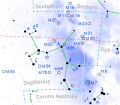M22 (星团)
| M22 | |
|---|---|
 M22的核心 | |
| 观测资料 (J2000 历元) | |
| 星座 | 人马座 |
| 赤经 | 18h 36m 23.94s[1] |
| 赤纬 | –23° 54′ 17.1″[1] |
| 距离 | 10.6 ± 1.0 kly(3 ± 0.3 kpc)[2] |
| 视星等 (V) | +5.1[3] |
| 视大小 (V) | 32 弧分 |
| 物理特征 | |
| 质量 | 2.9×105[4] M☉ |
| 半径 | 50 ± 5 ly[5] |
| 估计年龄 | 12 Gyr[6] |
| 值得注意特征 | 已知含有行星状星云的4个球状星团之一。 |
| 其他特征 | NGC 6656, GCl 99[7] |
M22或梅西耶22,也称为NGC 6656,位于人马座,是靠近银河系核心隆起的核球区域的椭圆形球状星团。它是夜空中可见最明亮的球状星团之一,可以用双筒望远镜观赏。最亮的恒星视星等为11等,使用8"望远镜可以解析出数百颗较亮的恒星[8]。M22的位置在星群"茶壶"的最北端,斗宿二(人马座λ)的西北面,恰好位在黄道的南面。
观测史[编辑]
M22是亚伯拉罕·依勒在1665年8月26日发现的第一批球状星团之一[2],在1764年6月5日被夏尔·梅西耶收录到类彗星天体的目录中。它是哈洛·沙普利在1930年首先仔细研究的第一批球状星团之一。它发现大约有70,000颗恒星,并且有一个密集的核心[9]。之后,赫顿·阿普和威廉·墨尔本在1959年继续研究它[10]。由于它在红巨星分支(RGB)有大量的色彩分布,与半人马座ω中观察到的相似,因此从1977年开始,它成为James E. Hesser等人严格审视的天体[2][11]。
性质[编辑]
M22是距离地球最近的球状星团之一,距离大约10,600光年。它跨越天空32'的弧度,相当于直径为99±9光年;在M22中已经发现32颗变星。它投射在银河系隆起的核球前面,因此对背景中的核球内的恒星有很好的微透镜效果[6]。
尽管它离我们相对很近,但这个贫金属星团的光受到尘埃消光的抑制,其视星等只有5.5等,但仍是北半球中纬度地区(指欧洲和北美洲大部分地区)可见最亮的球状星团[12]。然而,也因为它的位置偏南,在北半球可见的高度不会很高,所以不太为北半球的观测者注意,不像同属夏季的球状星团M13和M5那样令人印象深刻。
行星状星云[编辑]
M22非常不寻常,因为它是4个包含行星状星云的球状星团之一(其余3个是M15、NGC 6441和帕洛玛6。)。它是弗雷德·吉列等人从IRAS卫星1986年的资料中发现的点光源(IRAS 18333-2357)[13],吉列等人在1989年鉴定为行星状星云[14]。行星状星云中心的恒星是一颗蓝星,估计这个行星状星云(命名为GJJC1)只有6,000年的历史[2]。
黑洞[编辑]
在M22中发现两个质量在10到20太阳质量的黑洞。最初,是在新墨西哥州的电波望远镜甚大天线阵(VLA)发现,并在2012年得到钱卓X射线天文台的证实[15]。它们的探测表明,黑洞从星团中发射出的引力没有之前认为的有效,并估计M22内总共有5到100个不同数量黑洞的推测[16]。恒星和黑洞之间的相互作用可以解释星团异常大的核心[16]。
图集[编辑]
相关条目[编辑]
参考资料[编辑]
- ^ 1.0 1.1 Goldsbury, Ryan; et al. The ACS Survey of Galactic Globular Clusters. X. New Determinations of Centers for 65 Clusters. The Astronomical Journal. December 2010, 140 (6): 1830–1837. Bibcode:2010AJ....140.1830G. arXiv:1008.2755
 . doi:10.1088/0004-6256/140/6/1830.
. doi:10.1088/0004-6256/140/6/1830.
- ^ 2.0 2.1 2.2 2.3 Monaco, L.; Pancino, E.; Ferraro, F. R.; Bellazzini, M. Wide-field photometry of the Galactic globular cluster M22. Monthly Notices of the Royal Astronomical Society. 2004, 349 (4): 1278–1290. Bibcode:2004MNRAS.349.1278M. arXiv:astro-ph/0401392
 . doi:10.1111/j.1365-2966.2004.07599.x.
. doi:10.1111/j.1365-2966.2004.07599.x.
- ^ Galactic Globular Clusters Database (M22). [2020-08-17]. (原始内容存档于2009-06-03).
- ^ Marks, Michael; Kroupa, Pavel. Initial conditions for globular clusters and assembly of the old globular cluster population of the Milky Way. Monthly Notices of the Royal Astronomical Society. August 2010, 406 (3): 2000–2012. Bibcode:2010MNRAS.406.2000M. arXiv:1004.2255
 . doi:10.1111/j.1365-2966.2010.16813.x. Mass is from MPD on Table 1.
. doi:10.1111/j.1365-2966.2010.16813.x. Mass is from MPD on Table 1.
- ^ From trigonometry: radius = distance × sin( diameter_angle / 2 ) = 50 ly
- ^ 6.0 6.1 Gaudi, B. Scott. Interpreting the M22 Spike Events. Astrophysical Journal. 2002, 566 (1): 452–462. Bibcode:2002ApJ...566..452G. arXiv:astro-ph/0108301
 . doi:10.1086/338041.
. doi:10.1086/338041.
- ^ M 22. SIMBAD. 斯特拉斯堡天文资料中心. [2006-11-15].
- ^ Burnham's Celestial Handbook, vol.3, p.1594-1599
- ^ Shapley, Harlow. The Mass-Spectrum Relation for Giant Stars in the Globular Cluster Messier 22. Harvard College Observatory Bulletin. 1930, 874: 4–9. Bibcode:1930BHarO.874....4S.
- ^ Arp, H. C.; Melbourne, W. G. Color-magnitude diagram for the globular cluster M22. Astronomical Journal. 1959, 64: 28. Bibcode:1959AJ.....64...28A. doi:10.1086/107848.
- ^ Hesser, J. E.; Hartwick, F. D. A.; McClure, R. D. Cyanogen strengths and ultraviolet excesses of evolved stars in 17 globular clusters from DDO photometry. Astrophysical Journal Supplement Series. 1977, 33: 471. Bibcode:1977ApJS...33..471H. doi:10.1086/190438.
- ^ Ivans, I.; Sneden, C.; Wallerstein, G.; Kraft, R. P.; Norris, J. E.; Fulbright, J. P. & Gonzalez, G. On the Question of a Metallicity Spread in Globular Cluster M22 (NGC 6656). Memorie della Società Astronomica Italiana. 2004, 75: 286. Bibcode:2004MmSAI..75..286I.
- ^ Gillett, F. C.; Neugebauer, G.; Emerson, J. P.; Rice, W. L. IRAS 18333-2357 – an unusual source in M22. Astrophysical Journal. 1986, 300: 722–728. Bibcode:1986ApJ...300..722G. doi:10.1086/163846.
- ^ Cohen, J. G.; Gillett, F. C. The peculiar planetary nebula in M22 (PDF). Astrophysical Journal. 1989, 346: 803–807 [2020-08-17]. Bibcode:1989ApJ...346..803C. doi:10.1086/168061. (原始内容存档 (PDF)于2019-09-23).
- ^ Gary, Stuart. Astronomers discover twin black holes. ABC Science News. Australian Broadcasting Corporation. 4 October 2012 [5 October 2012]. (原始内容存档于2013-08-14).
- ^ 16.0 16.1 Strader, J.; Chomiuk, L.; MacCarone, T. J.; Miller-Jones, J. C. A.; Seth, A. C. Two stellar-mass black holes in the globular cluster M22. Nature. 2012, 490 (7418): 71–73. Bibcode:2012Natur.490...71S. PMID 23038466. arXiv:1210.0901
 . doi:10.1038/nature11490.
. doi:10.1038/nature11490.
引证错误:在<references>标签中name属性为“hcob849_11”的参考文献没有在文中使用
<references>标签中name属性为“mnras404_3_1203”的参考文献没有在文中使用外部链接[编辑]
| 维基共享资源上的相关多媒体资源:M22 |
- Messier 22, SEDS Messier pages (页面存档备份,存于互联网档案馆)
- Messier 22, Galactic Globular Clusters Database page (页面存档备份,存于互联网档案馆)
- NASA Astronomy Picture of the Day: Globular Cluster M22 from CFHT (27 June 2005)
- NASA Astronomy Picture of the Day: M22 and the Wanderers (April 12, 2018)
- Merriefield, Mike. M22 – Globular Cluster. Deep Sky Videos. Brady Haran. [2020-08-17]. (原始内容存档于2020-07-02).
- WikiSky上关于M22 (星团)的内容:DSS2, SDSS, GALEX, IRAS, 氢α, X射线, 天文照片, 天图, 文章和图片
天球赤道座标:![]() 18h 36m 24.21s,−23° 54′ 12.2″
18h 36m 24.21s,−23° 54′ 12.2″
| |||||||||||||||||||||||||||||||||||||||||||||||||||||||||||||||||||||


